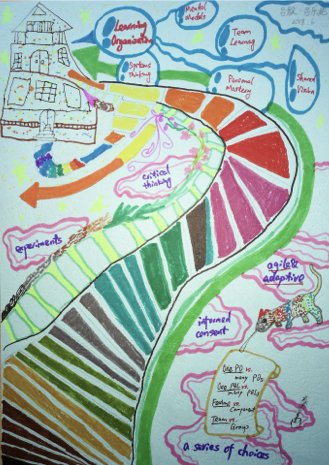(Originally published on Odd-e’s blog on Jun 15, 2018.)
As part of the LeSS trainer application, I was asked to give a graphical representation of LeSS. Here’s the result showing my view of LeSS:

LeSS is a series of choices for large-scale product development. We could make any choice if we are not clear about the optimizing goal. The choices made by LeSS are optimized for agility and adaptiveness. Among others, two choices stand out:
To get the informed consent about adopting LeSS, i.e. making a series of choices, we should explore and see the system dynamics behind those choices. This is why systems thinking is critical in understanding LeSS.
Systems thinking sounds great, thus, it could be claimed to be relevant anywhere. LeSS applies it concretely to evaluate the choices you make. What is the system optimizing goal? What are your choices? What are the causes behind them? What are the consequences? Are they consistent with your system optimizing goal?
I am often asked to compare LeSS with SAFe and other frameworks. I don’t have an answer, but would like to offer an exercise of system modeling on the different choices those frameworks offer. We evaluate those by applying systems thinking.
When a team gets big, we split it into two. How? Typically by dividing into components or sub-components. Why do we split this way? What are the consequences? What are the alternatives? Often, we did not think it through. That is the typical manifestation of fast thinking. However, those choices are so important that they deserve slow thinking. System modeling helps us do slow thinking, and critical thinking.
If you practice systems thinking on your choices, you are free to do experiments that may not be consistent with LeSS. Eventually, you “own” what you do, rather than “rent” ideas from others. Less copying, more learning.
Systems thinking is the cornerstone (i.e. the fifth discipline) for a learning organization. LeSS opens up the stairway to a learning organization in the field of product development. By experimenting and practicing the five disciplines, we move toward the learning organization, while LeSS is a starting point in the journey.
This is my view of LeSS.
P.S. I had to ask my daughter for help in doing this graphical representation. I noticed a small detail afterwards. There are two paths to the house representing the learning organization. One is through the back door, which is the shorter route; the other is through the front door, which is the longer route. They happen to be a good representation of fast thinking and slow thinking.